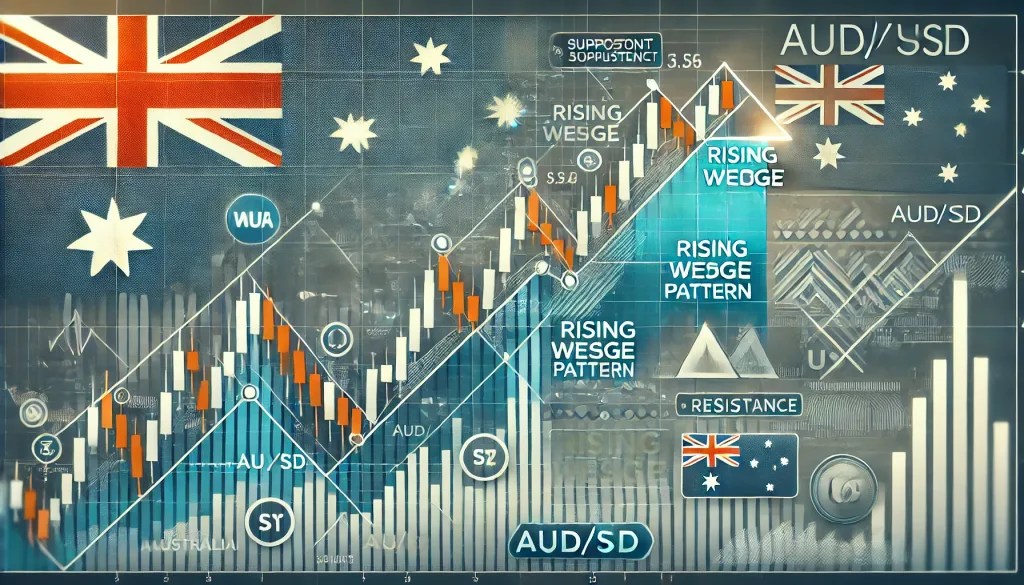The AUD/USD Rising Wedge: A Hidden Pattern That Can Predict Big Moves

Let’s talk about a shape in the forex world that’s sneakier than a toddler hiding with chocolate all over their face: the rising wedge. If you’re trading AUD/USD, this pattern might just become your new best frenemy. Why? Because when you know how to spot it, it’s like having a cheat code to predict price reversals. Miss it, though, and your trading account might feel like that sitcom character who always gets the short end of the stick.
What is a Rising Wedge?
Imagine price action climbing like someone attempting to walk up an escalator going down. It’s working… but not for long. That’s your rising wedge. It’s a bearish reversal pattern that forms when price consolidates between upward-sloping support and resistance lines. The kicker? The support line rises faster, pinching the price into a tighter range until—bam—it breaks down.
Key Characteristics:
- Sloping Lines: Both support and resistance lines slope upward.
- Converging Structure: The distance between the two lines narrows over time.
- Volume Decline: Volume usually drops during the formation, signaling waning momentum.
Why AUD/USD Loves a Good Rising Wedge
The AUD/USD pair has a reputation for being sensitive to global risk sentiment, commodity prices, and central bank policies. Rising wedges often appear during moments of market hesitation. For example:
- Risk-On Rally Stalls: Traders push AUD/USD higher, but with diminishing conviction.
- Commodity Dependency: A dip in iron ore prices (Australia’s main export) could coincide with a rising wedge breakdown.
- Fed vs. RBA: Diverging monetary policies between the U.S. Federal Reserve and the Reserve Bank of Australia can add fuel to the fire.
How to Spot a Rising Wedge in AUD/USD
Here’s a step-by-step guide:
- Find the Trend: Rising wedges usually form in uptrends. Look for AUD/USD climbing steadily but struggling to gain ground.
- Draw Trendlines: Connect at least two higher highs and two higher lows to create your wedge.
- Check Volume: If volume is decreasing as price rises, you’ve likely got a textbook wedge.
- Wait for the Breakout: Rising wedges typically break to the downside. The key is patience—wait for confirmation before entering a trade.
Why Most Traders Get It Wrong (And How You Can Avoid It)
Many traders misinterpret rising wedges as continuation patterns. Here’s why that’s a recipe for disaster:
- FOMO Trading: Jumping in too soon can lead to losses if the pattern doesn’t break as expected.
- Ignoring Volume: Without volume analysis, you’re flying blind.
- Skipping Risk Management: Always set a stop-loss just above the resistance line to avoid wiping out your account.
Proven Strategies for Trading the AUD/USD Rising Wedge
1. The Breakout Trade
Once the wedge breaks below support, enter a short trade. Confirm with:
- Volume Spike: A sudden increase in volume signals a strong breakout.
- Indicators: Use RSI to check for overbought conditions before the breakdown.
2. Retest Entry
If you miss the initial breakout, wait for a retest of the broken support (now resistance). This gives you a second chance to enter with a tighter stop-loss.
3. Combine with Fundamentals
Check key economic events that could amplify the move, like:
- Fed Rate Announcements
- RBA Policy Statements
- China’s Economic Data (as Australia’s largest trading partner)
Case Study: AUD/USD Rising Wedge in Action
In May 2023, AUD/USD formed a rising wedge between 0.6600 and 0.6750. Traders were optimistic about Australia’s trade surplus, but iron ore prices started slipping. As the wedge tightened, volume dried up. When China released disappointing manufacturing data, the wedge broke below 0.6600, leading to a swift drop to 0.6450.
Key Takeaways:
- The pattern formed during a period of mixed sentiment.
- Volume analysis and fundamental triggers confirmed the breakdown.
- Patient traders who waited for a retest maximized their profits.
Ninja Tactics for Mastering Rising Wedges
- Use Fibonacci Levels: Combine wedge analysis with Fib retracements to pinpoint potential targets.
- Set Alerts: Use trading platforms to notify you when price nears key trendlines.
- Practice on Demo Accounts: Test your strategy without risking real money.
Why Join the StarseedFX Community?
- Real-Time Forex News: Stay ahead of the curve with exclusive updates. Check it out here.
- Advanced Forex Education: Learn to spot patterns like a pro. Start your journey.
- Smart Trading Tools: Simplify your analysis and optimize trades. Discover more.
Wrap-Up: Turn Rising Wedges into Opportunities
The rising wedge is a powerful pattern for predicting AUD/USD reversals, but only if you understand its nuances. By combining technical analysis, volume signals, and fundamental insights, you can trade this pattern with confidence.
—————–
Image Credits: Cover image at the top is AI-generated
PLEASE NOTE: This is not trading advice. It is educational content. Markets are influenced by numerous factors, and their reactions can vary each time.

Anne Durrell & Mo
About the Author
Anne Durrell (aka Anne Abouzeid), a former teacher, has a unique talent for transforming complex Forex concepts into something easy, accessible, and even fun. With a blend of humor and in-depth market insight, Anne makes learning about Forex both enlightening and entertaining. She began her trading journey alongside her husband, Mohamed Abouzeid, and they have now been trading full-time for over 12 years.
Anne loves writing and sharing her expertise. For those new to trading, she provides a variety of free forex courses on StarseedFX. If you enjoy the content and want to support her work, consider joining The StarseedFX Community, where you will get daily market insights and trading alerts.
Share This Articles
Recent Articles
The GBP/NZD Magic Trick: How Genetic Algorithms Can Transform Your Forex Strategy
The British Pound-New Zealand Dollar: Genetic Algorithms and the Hidden Forces Shaping Currency Pairs
Chande Momentum Oscillator Hack for AUD/JPY
The Forgotten Momentum Trick That’s Quietly Dominating AUD/JPY Why Most Traders Miss the Signal
Bearish Market Hack HFT Firms Hope You’ll Never Learn
The One Bearish Market Hack High Frequency Traders Don't Want You to Know The

